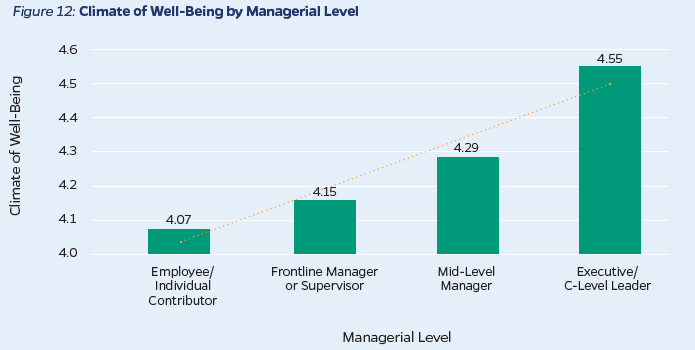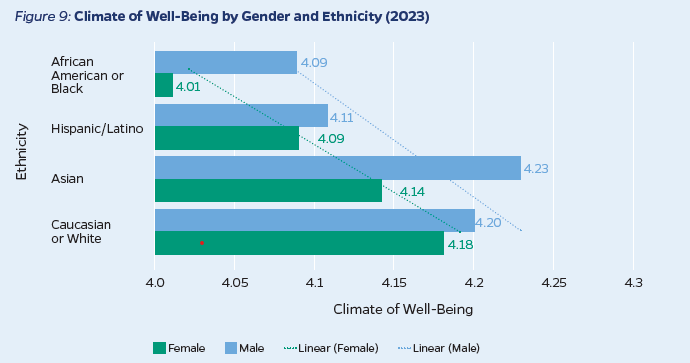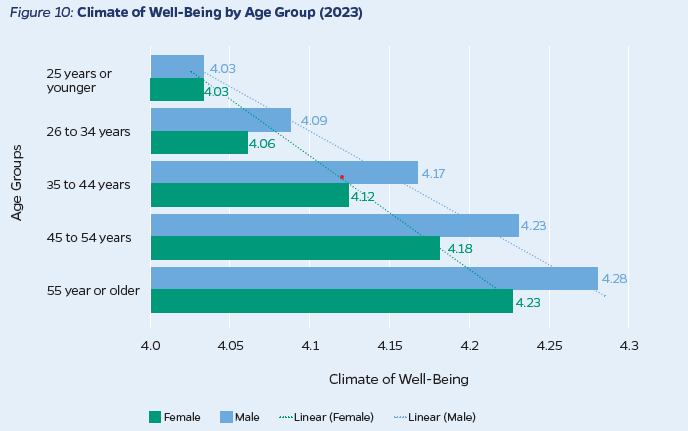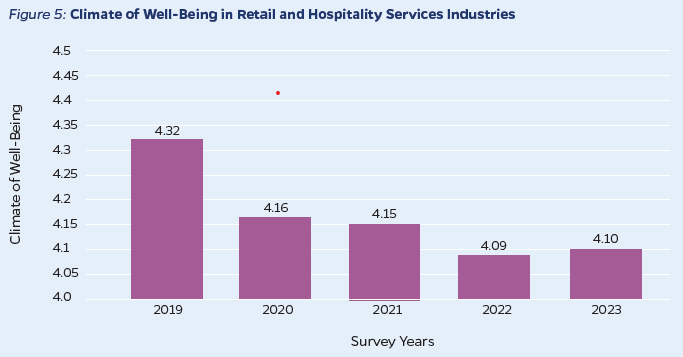Diversity & Inclusion, Employee Well-being
Well-being in the U.S. has steadily declined since 2020, with certain groups disproportionately affected, according to a new report from Johns Hopkins University and Great Place To Work.
Employee well-being took center stage during the pandemic as people juggled working from home, long hours, layoffs, and the stress of a never-ending crisis.
But as the pandemic drifts into the rearview mirror, so has the focus on well-being.
A new report from Johns Hopkins Carey Business School in partnership with Great Place To Work® shows that well-being peaked in 2020, but has declined over the past three years as mandates rise and support for flexible work declines.
Researchers, using over 1.5 million employee survey responses across more than 2,500 organizations, developed a well-being index based on a five-point scale, using five criteria to define a healthy workplace: mental and emotional support, sense of purpose, personal support, financial health, and meaningful connections.
The results are telling: Well-being hit 4.21 in 2020 at the height of the pandemic, but has steadily dropped to 4.11, nearly the same as the pre-pandemic level of 4.10 in 2019.
Returning to baseline is disappointing, but the disparities in the employee experience should give leaders even more pause. African Americans, women, young people, and individual contributors are faring worse than their white, male, and older counterparts.
Not supporting all employee groups comes at a high price. Great Place To Work research shows that companies that supported five key employee groups (women, frontline workers, hourly workers, people of color, and long tenured workers) during times of crisis posted a remarkable 14.4% market gain.
Similarly, the report found the Fortune 100 Best Companies to Work For® had higher returns on invested capital and higher total returns to shareholders over time, echoing findings that the 100 Best more than tripled their stock performance. These companies — the best of the best — prove that high well-being and strong business results can coexist.
The report looked at well-being across different demographic groups, highlighting differences based on gender, ethnicity, age, and job level. Understanding these gaps is the first step to knowing what needs to be fixed. Here’s a look:
Key findings
1. Well-being drops as you move down the organizational chart
Individual contributors reported the lowest well-being scores while senior executives reported the highest, revealing a clear trend: Well-being improves with higher managerial levels.
The report also found a connection between well-being and confidence in management. Employees with a “great deal” of confidence in executives had higher well-being levels than those with “very little.” In fact, a separate research study showed trust in leadership at the 100 Best remained steady before, during, and after the pandemic.

2. Retail, hospitality, and health care industries struggle the most
Although all industries were hit during the pandemic, retail, healthcare and hospitality scored the lowest, while financial services saw a temporary boost during the pandemic but have since returned to pre-pandemic levels.
- Retail and hospitality: Struggled during the pandemic with declining well-being scores, which remain lower than pre-pandemic levels.
- Health care: Well-being scores for this group rose slightly in 2020 and have hovered around the same levels since
- Financial services: Experienced a temporary increase in well-being scores during the pandemic but returned to pre-pandemic levels.
- Information and technology, and professional services: Scores in these industries didn’t change much in 2020, but they have declined in the years since.
3. Women and Black employees experience consistently low well-being levels
Despite the gender gap narrowing in 2020 and all ethnicities reporting their highest levels of well-being that year, scores have declined. Women had consistently lower well-being scores compared with men, as did Black workers compared with other ethnic groups.
And when comparing well-being scores for men and women across four ethnic groups, the Asian and African American groups had the largest gaps, with men significantly and consistently outscoring women.

4. Older workers report better work climate than their younger colleagues
Historically, well-being scores tended to decline with advancing age, but the data from 2020 to 2023 reveals a reversal. During this period, older employees reported higher well-being scores compared to their younger counterparts, no matter the gender. Younger age groups, particularly those aged 25 and younger and 26 to 34, showed more significant fluctuations in well-being than older groups.

5. Link between remote work and high well-being levels
Flexible work arrangements and remote work positively impact well-being: organizations with higher percentages of remote or flexible work report better well-being scores.
Workplaces where 75% or more of employees can work remotely part-time had high scores, and workplaces where less than 25% of employees could do the same had the lowest score.
Great Place To Work research cautions that while remote work is correlated with higher levels of well-being, it’s not a solve for toxic company culture. It’s less about where you work than whether you have a choice to work onsite, hybrid, or remote, according to the “Return-to-Office Mandates and the Future of Work” report.
Workplaces unable to offer remote work, such as retail and hospitality, have developed flexibility in schedule and role. Hear how Wegmans and Marriott offer flexibility for their workers.
What’s next?
Workplace inequities come with a heavy price. If all employee groups don’t feel seen, heard, and valued, businesses suffer. Productivity, agility, innovation, and retention all drop. But if you care for your people — all people — they will care for you, work hard for you, and stay with you.
Great Place To Work research shows that it is leaders who create the employee experience, which in turn creates the culture, which drives business performance.
It’s essential to know your people and have ways to hear from all groups. Here are four actions to take today:
1. Survey your people. You can’t know what gaps exist at your workplace if you don’t ask your people about the experience they’re having. Use tools like the Trust Index™ survey and pulse surveys to gather data and insights to understand what is and isn’t working.
2. Establish employee resource groups (ERGs). ERGs help employees feel a sense of belonging and are powerful sources of innovation, talent development, and revenue growth. They ensure you’re hearing from all voices, especially marginalized workers. ERGs for women at Cadence, for example, influence business decisions around policies and programs, helping the tech company attract and retain female talent.
3. Improve leadership behaviors. Practice the nine high-trust leadership behaviors, with listening being the most important. Create spaces where you’re listening to your people through 1:1s, town halls, or other ways, but make sure it’s consistent.
4. Have skip-level meetings. Senior managers should engage with employees at all levels to understand workplace dynamics better. You can’t assume your experience, or that of your direct reports, is the same as that of an individual contributor a few rungs down the organizational chart. In fact, it often isn’t.
Leadership comes with great responsibility. It’s up to you to create a people-first culture. Make their well-being a priority, and they will trust you, work hard for you, and stay with you.












